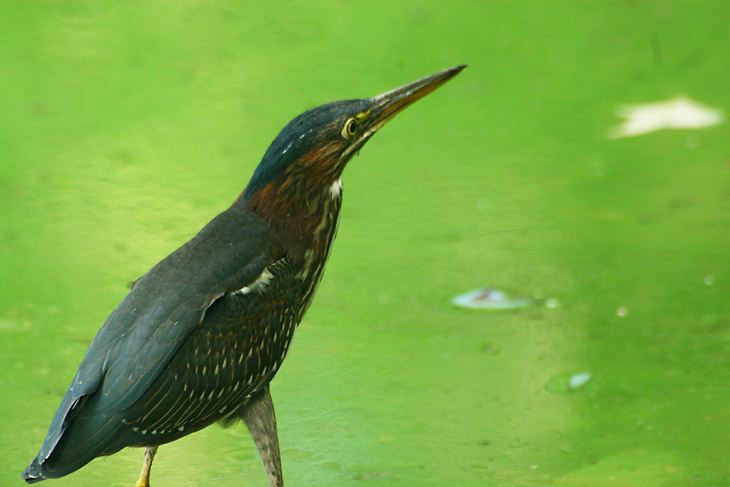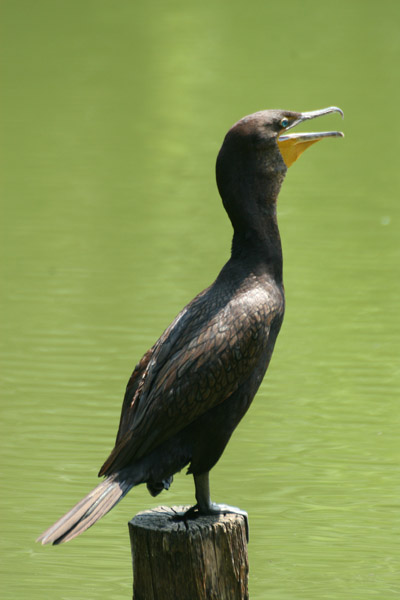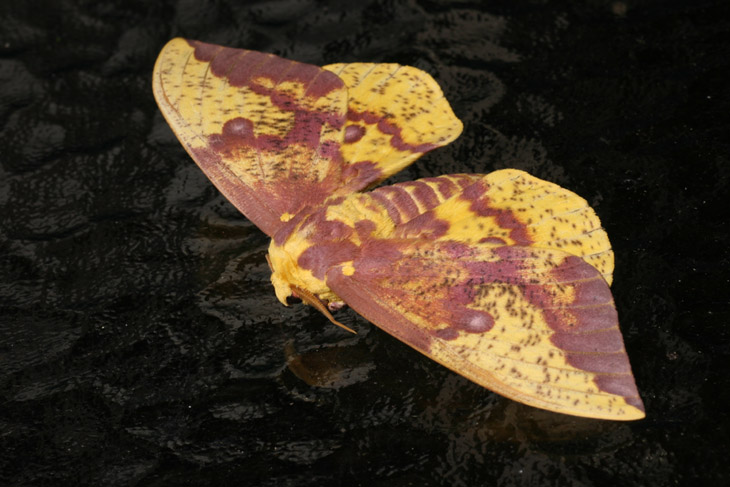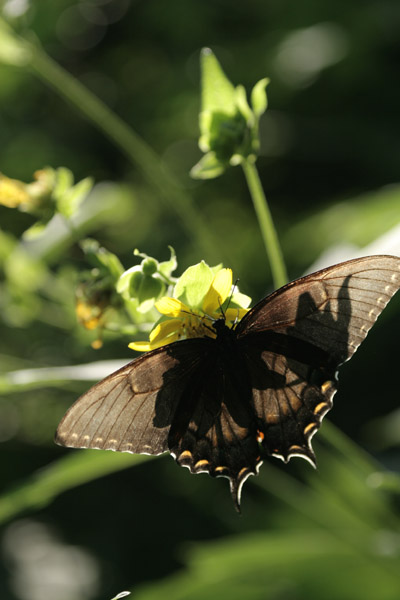
This post serves a double purpose, both to show off a handful of recent photos and serve as a buffer before another gout of mantis pics comes crashing in. As even further warning of that upcoming post, a lot of them are going to be really weird looking.
Yesterday morning, I watched a pair of green herons (Butorides virescens) at the nearby pond. The image above is probably the best I got, and not all that good at that – to do these justice, I need to be shooting from a tripod and not handheld. A tripod, however, does not allow much freedom of movement when the subject starts wandering in and out of view along the shoreline. Green herons have a peculiar call, similar to the sharp chirp of a basketball shoe on the court but much deeper in pitch, and herons generally don’t issue it unless they’re startled or irritated. A series of the calls convinced me to approach cautiously, and I witnessed a pair of them in a curious dance, often close together but not too close, not apparently courting nor apparently antagonistic, but at times one would approach the other and send that one winging off along the shore, with the first in close pursuit, and they did this three times in my immediate vicinity. Since they are distinctly shy birds, getting this close for photos, even with the long lens, wasn’t typical, and I surmise that they were more intent on their own interactions than my presence.
[Now, a short aside. Obviously I put effort into including the scientific names of species with these posts, but this one has provoked a lot of backtracking and an irritated sigh. I have listed everywhere else that the scientific name of the green heron is Butorides striatus, but it’s not; it’s Butorides virescens. The two species were apparently linked in some way, but all references I can find right now give the latter name. The reason I’ve been using the incorrect one? That’s the one I found when I first did the page in my gallery with a heron, and I’ve been using that as my reference ever since. What this means is that I now have to correct a webpage, the blog tags, and two previous blog posts over this, all because my original source was wrong and I never checked another. Sheesh.]
 As threatened, I also got a slightly better view of the double-crested cormorant (Phalacrocorax auritus,) who to all appearances has not been handling the heat well, often seen exactly like this: beak open, reluctant to exert any effort. The deep green backgrounds of both of these photos is another facet of this heat; we’d been a long time without rain or a significant drop in temperature, resulting in undisturbed water that has provoked a rich algae bloom. It sets off the eyes nicely, don’t you think? While not the best light angle, I did manage a shot that illustrated this trait, but I may not get anything better; the favored perch of this bird provides roughly ninety degrees of visual access from any nearby point, and all of that is opposite the sun, so getting good light on those eyes is going to require the bird to find a completely different location.
As threatened, I also got a slightly better view of the double-crested cormorant (Phalacrocorax auritus,) who to all appearances has not been handling the heat well, often seen exactly like this: beak open, reluctant to exert any effort. The deep green backgrounds of both of these photos is another facet of this heat; we’d been a long time without rain or a significant drop in temperature, resulting in undisturbed water that has provoked a rich algae bloom. It sets off the eyes nicely, don’t you think? While not the best light angle, I did manage a shot that illustrated this trait, but I may not get anything better; the favored perch of this bird provides roughly ninety degrees of visual access from any nearby point, and all of that is opposite the sun, so getting good light on those eyes is going to require the bird to find a completely different location.
If you’re trying to see the double crest, don’t bother. It’s not there right now, and indeed, I’m never seen it myself, but this species develops two thin stripes of longer white feathers on the head during breeding season, which lasts a couple of months at best, and this distinction somehow fostered the name. Go figure.

The other evening while out watering the plants, I heard a faint scuffling sound from the deck, significant enough to make me think it was a rodent of some kind. Instead, I found a large pink and yellow moth, the size of a luna moth, thrashing on the boards. The pic above was one of the few where it was holding still – most times, it was fluttering rather ineptly, barely getting off the ground. This is an imperial moth (Eacles imperialis,) the first I’ve ever seen, and like the luna, it seems their adult phase is dedicated entirely to reproduction; they have no feeding organs at this stage.

The lack of a proboscis/siphon is subtle and not entirely clear, but I like how the ‘fur’ is continued up onto the base of the antennae. Because, you know, the nights sometimes aren’t sticky sweaty dripping hot, but merely warm. While I wanted a better angle, this is actually the only frame I got before it began thrashing around again, and after perhaps half an hour of trying, I simply let it go. Whereupon it immediately flew onto the porch screens and sat there obediently, too high now to reach (suspended over the dropoff in the back,) and too obscured by the screen for the shots I wanted, even though I had a great view of the underside. The entomologists out there would probably ask, “Why didn’t you just stick a pin through it?” while others would be horrified that I even interrupted its life in this way.
 A few weeks back, an outing with a student was providing highly variable and scattered lighting conditions, but I took advantage of this to shoot a backlit eastern tiger swallowtail butterfly (Papilio glaucus) while it dined at a flower. If you’re not familiar with their appearance, this image doesn’t help, because they’re black with little edge markings in color – the wings are just thick enough to let a lot of light through in the right conditions. Eastern tiger swallowtails are often yellow, with black wing veins and the same edge markings, but the females can frequently have a black phase shown here, and will be interspersed among the yellows in any congregation of the species.
A few weeks back, an outing with a student was providing highly variable and scattered lighting conditions, but I took advantage of this to shoot a backlit eastern tiger swallowtail butterfly (Papilio glaucus) while it dined at a flower. If you’re not familiar with their appearance, this image doesn’t help, because they’re black with little edge markings in color – the wings are just thick enough to let a lot of light through in the right conditions. Eastern tiger swallowtails are often yellow, with black wing veins and the same edge markings, but the females can frequently have a black phase shown here, and will be interspersed among the yellows in any congregation of the species.
Here’s where it gets interesting. Very often, contrasting colors on an arthropod species is an example of aposematic coloration, or ‘keepaway’ signals, and is displayed in conjunction with some kind of defense, whether it be stinging or the emission of some foul-tasting or toxic substance; monarch butterflies are one such species. Monarchs look quite similar to the yellow phase of this species, only rich orange instead of yellow – it’s very easy to tell the difference, but because more people are familiar with monarchs and not swallowtails, this species is often mistaken for a monarch. There is another form of defense, called Batesian mimicry, where a perfectly edible species looks like a toxic/unpalatable one, and is thus not bothered by predators which have a bad experience with the other. Is this what’s going on with the yellow phase, which accounts for roughly 3/4 of the specimens (all males and half of the females)? Not sure. But, the dark phase of the females resembles the toxic pipevine swallowtail, and so that phase, at least, is Batesian. Now, I’m not sure I’ve seen a pipevine swallowtail around here, but I am sure I haven’t seen a monarch in ages, and their numbers are noticeably dwindling, so there’s reason to believe the dark phase of the tiger swallowtails may become more prevalent because they have a more effective defense.
 And finally, another outing produced this striking pair, handily, because I’d been telling the enigmatic Mr. Bugg how to identify the males from the females. These are black-and-yellow Argiopes (Argiope aurantia,) often called garden spiders, and the male is closest to us – unfortunately this means the striking coloration of the female is not apparent, but you can always see it better here. This is courting behavior, and if I wasn’t with a student I might’ve waited to see if anything was going to happen, but that’s not something I would do while on the clock unless there were indications that the denouement was imminent. Since they appeared completely placid and no mood music was playing, I didn’t wait around to see if they’d start to tango. I did photograph one such encounter before, to all appearances an unsuccessful one. You’re going to ask what constitutes sex appeal in arachnids, I just know it, and I can’t really tell you – it’s not size that matters, obviously. I’m going to go with “sense of humor” because I keep hearing that, even when I suspect it’s defined differently from how I personally define it. And I’ll just let you ponder that one…
And finally, another outing produced this striking pair, handily, because I’d been telling the enigmatic Mr. Bugg how to identify the males from the females. These are black-and-yellow Argiopes (Argiope aurantia,) often called garden spiders, and the male is closest to us – unfortunately this means the striking coloration of the female is not apparent, but you can always see it better here. This is courting behavior, and if I wasn’t with a student I might’ve waited to see if anything was going to happen, but that’s not something I would do while on the clock unless there were indications that the denouement was imminent. Since they appeared completely placid and no mood music was playing, I didn’t wait around to see if they’d start to tango. I did photograph one such encounter before, to all appearances an unsuccessful one. You’re going to ask what constitutes sex appeal in arachnids, I just know it, and I can’t really tell you – it’s not size that matters, obviously. I’m going to go with “sense of humor” because I keep hearing that, even when I suspect it’s defined differently from how I personally define it. And I’ll just let you ponder that one…




















































